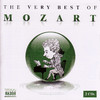Wolfgang Amadeus Mozart
Biography
This Austrian composer and child prodigy was a major figure in the classical period who wrote in most musical forms of the time, especially opera, symphony, concertos, and chamber music; his notable works are too numerous to mention. Mozart had a great and lively mind, which he engaged in such experiments as deciding progressions by playing dice and billiards, placing players in adjacent rooms echoing each other (Notturno for Four Orchestras, K. 269), and the encoding of Masonic rituals in The Magic Flute. Mozart was capable of the most earthshaking and profound works (Requiem, K. 626, written as he lay on his deathbed), the sweetest of arias in his many operas, and the most beautiful of melodic invention and variation (the piano concertos, Eine Kleine Nachtmusik, and much more). His feeling for the balance of lines that have separate functions (melody, accompaniment, sostenuto, and melisma) is revealed in the quintets, the Sinfonia Concertante in E-flat, and the string quartets. Many structures in his symphonies are copies of innovations by Haydn, in some ways more conservative, but their drive, surprising modulations, and memorable melodies are purely Mozart. . This Austrian composer and child prodigy was a major figure in the classical period who wrote in most musical forms of the time, especially opera, symphony, concertos, and chamber music; his notable works are too numerous to mention. Mozart had a great and lively mind, which he engaged in such experiments as deciding progressions by playing dice and billiards, placing players in adjacent rooms echoing each other (Notturno for Four Orchestras, K. 269), and the encoding of Masonic rituals in The Magic Flute. Mozart was capable of the most earthshaking and profound works (Requiem, K. 626, written as he lay on his deathbed), the sweetest of arias in his many operas, and the most beautiful of melodic invention and variation (the piano concertos, Eine Kleine Nachtmusik, and much more). His feeling for the balance of lines that have separate functions (melody, accompaniment, sostenuto, and melisma) is revealed in the quintets, the Sinfonia Concertante in E-flat, and the string quartets. Many structures in his symphonies are copies of innovations by Haydn, in some ways more conservative, but their drive, surprising modulations, and memorable melodies are purely Mozart.
Top Albums |

1. Mozart, Verd..
 | 
2. The 50 Most ..
 | 
3. Mozart for Y..
 | 
4. Mozart for B..
 | 
5. Mozart: Requ..
 |

6. The 50 Darke..
 | 
7. 24 Hours of ..
 | 
8. Mozart - 100..
 | 
9. 99 Must-Have..
 | 
10. Mozart: Requ..
 |

11. Top 200 Clas..
 | 
12. Amadeus (Mus..
 | 
13. 100 Supreme ..
 | 
14. Rock of Ages..
 | 
15. The Very Bes..
 |

16. Mozart: Symp..
 | 
17. The 99 Most ..
 | 
18. 66 Most Beau..
 | 
19. Mozart: Viol..
 | 
20. 50 Classical..
 |
|
Top Songs |
| Name | Album | Time | Price | |
| 1. | Don Giovanni, Act I : Don Giovanni&#.. | Mozart, Verdi - EP | 1:35 | $0.99 |  |
| 2. | Die Zauberflöte / Czarodziejski fle.. | Mozart, Verdi - EP | 4:25 | $0.99 |  |
| 3. | Eine Kleine Nachtmusik | E Chli Ewig - Das Grosse Li.. | 3:09 | $0.99 |  |
| 4. | Piano Sonata No.11 In A Major K.311 .. | 출근길에 함께하는
|

